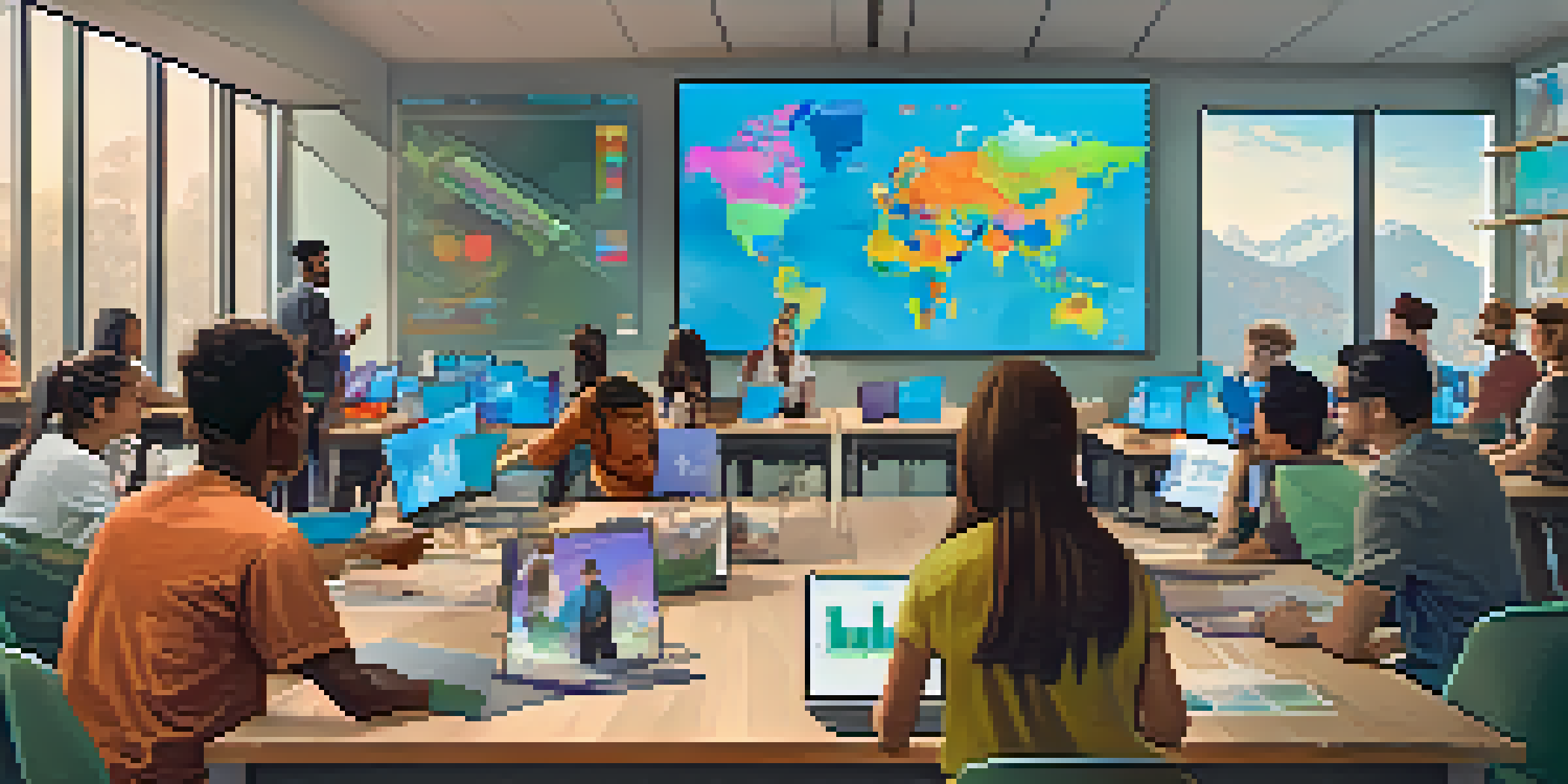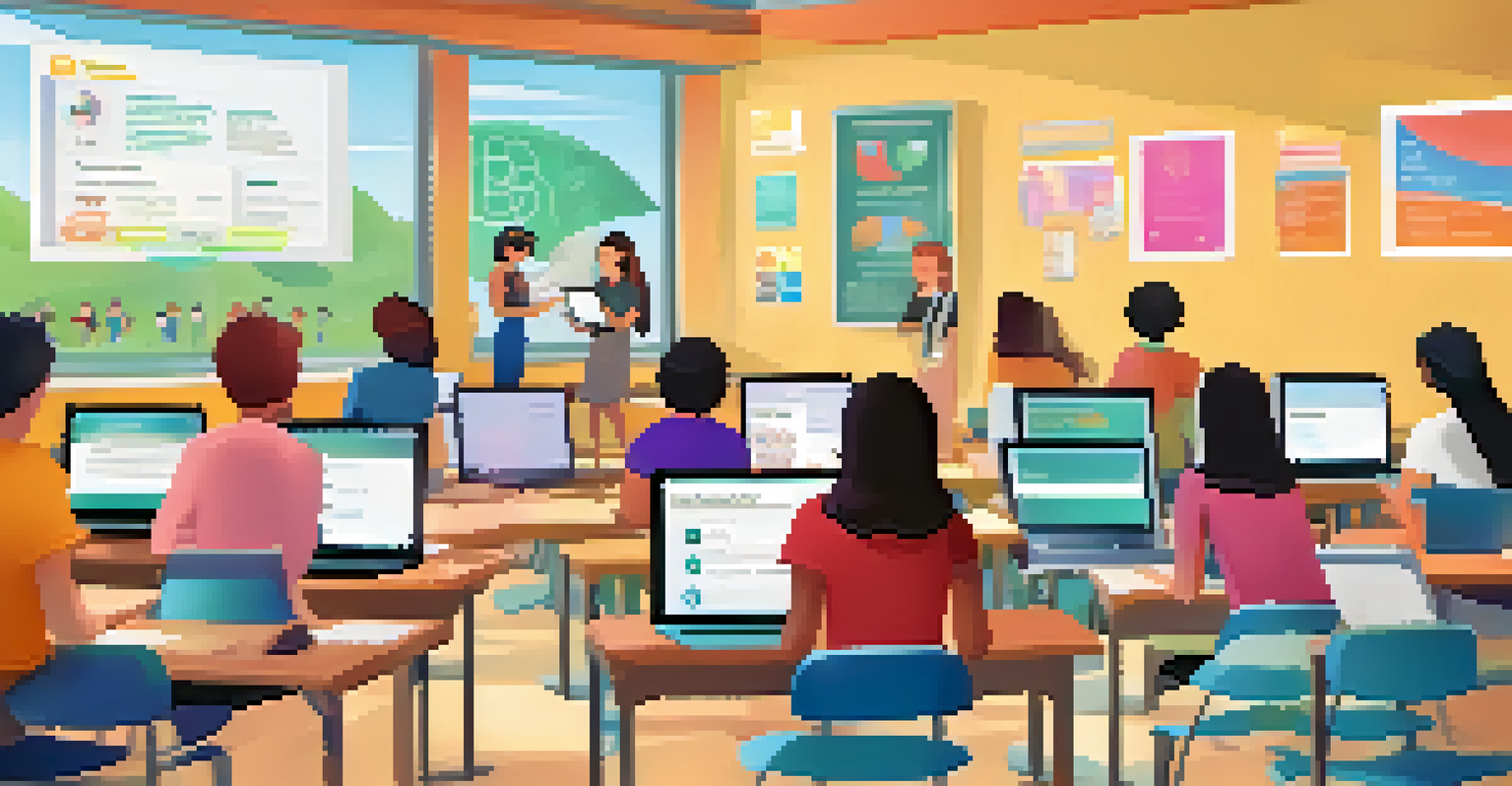Strategies for Encouraging Student Engagement in Digital Learning

Creating a Collaborative Online Learning Environment
Encouraging collaboration among students is vital in digital learning. By utilizing discussion boards and group projects, students can share ideas and learn from one another. This interaction fosters a sense of community, making learning less isolating and more engaging.
Collaboration allows us to know more than we are capable of knowing by ourselves.
Consider incorporating tools like Google Docs or Trello for team collaboration. These platforms allow students to work together in real-time, which can enhance their commitment to the task. Remember, when students feel connected to their peers, they are more likely to participate actively.
Additionally, setting up virtual study groups can help students stay accountable. When they know their classmates are counting on them, they’re more inclined to engage with the material. This sense of responsibility can significantly boost their motivation.
Incorporating Interactive Content into Lessons
Interactive content plays a crucial role in keeping students engaged. This can include quizzes, polls, and interactive videos that require student input. By making lessons more dynamic, students are more likely to stay focused and absorb the information presented.

For instance, using platforms like Kahoot! for quizzes can turn assessment into a fun game. This not only makes learning enjoyable but also reinforces the material through active participation. When students are entertained, they often retain information better.
Foster Collaboration Among Students
Encouraging collaboration through tools like discussion boards and group projects creates a sense of community and enhances student engagement.
Moreover, gamifying learning experiences can motivate students to complete tasks. By incorporating elements such as points, badges, or leaderboards, you can create a competitive yet friendly atmosphere that encourages engagement. Students love to achieve, and gamification taps into that desire.
Utilizing Real-World Applications for Learning
Connecting lessons to real-world applications can spark student interest. When students see how their learning applies outside the classroom, it becomes more meaningful and relevant. For example, using case studies from current events can illustrate theoretical concepts in action.
Education is not the filling of a pail, but the lighting of a fire.
Invite professionals from various fields to share their experiences and insights. Guest speakers can provide students with a fresh perspective and inspire them to engage with the subject matter. This exposure can ignite curiosity and encourage deeper exploration.
Additionally, encouraging students to undertake projects that benefit their community can enhance their engagement. When students see the impact of their work, they feel a sense of purpose, driving them to be more involved in their learning journey.
Providing Personalized Learning Experiences
Personalization is key to keeping students engaged in digital learning. By offering choices in assignments or topics, students can explore their interests while achieving learning objectives. This autonomy can lead to increased motivation and investment in their education.
Consider using learning management systems that adapt content based on student performance. These systems can provide tailored resources that challenge students at their individual levels, ensuring they remain engaged without feeling overwhelmed.
Utilize Interactive Learning Tools
Incorporating interactive content like quizzes and gamification makes lessons dynamic and keeps students focused.
Moreover, regular check-ins and feedback can help students feel supported in their learning journey. This personalized approach fosters a positive relationship between students and educators, encouraging students to participate actively.
Encouraging Student Feedback and Input
Creating a feedback loop is crucial for student engagement in digital learning. When students feel their opinions are valued, they are more likely to participate. Encourage them to share their thoughts on course content and teaching methods to foster a collaborative learning environment.
Implement anonymous surveys or suggestion boxes to collect honest feedback. This approach allows students to voice their opinions without fear of judgment, leading to more constructive insights. As a result, educators can adjust their strategies to better meet student needs.
Additionally, discussing the feedback openly in class can empower students. When they see changes based on their suggestions, they feel a sense of ownership over their learning experience, encouraging them to engage more actively.
Implementing Engaging Multimedia Resources
Incorporating multimedia resources can significantly enhance student engagement. Videos, podcasts, and infographics cater to different learning styles and can make complex concepts easier to understand. This variety keeps lessons fresh and exciting.
For example, using short video clips to introduce a topic can pique interest and stimulate discussion. Students are often more engaged when they can see and hear content rather than just reading text. Visual and auditory elements can make learning more memorable.
Personalize Learning Experiences
Providing personalized options in assignments helps students explore their interests, increasing motivation and investment in their education.
Additionally, encouraging students to create their own multimedia presentations can further enhance their engagement. This active participation allows them to express their understanding creatively, making the learning process more enjoyable.
Building a Supportive Online Community
Creating a supportive online community is essential for fostering student engagement. When students feel they belong to a group, they are more likely to participate in discussions and activities. Building rapport among students can be achieved through icebreakers and team-building exercises.
Regularly scheduled virtual hangouts or informal chats can also help students connect. These opportunities for social interaction can break down barriers and encourage collaboration. When students know their peers, they feel more comfortable sharing ideas and asking questions.

Furthermore, recognizing student achievements and contributions publicly can boost morale. Celebrating successes, no matter how small, reinforces a positive community atmosphere, encouraging more students to engage actively.
Leveraging Technology for Enhanced Engagement
Technology can be a powerful ally in promoting student engagement in digital learning. Utilizing various tools and platforms can enhance the learning experience and keep students excited about their education. From interactive whiteboards to virtual reality, the possibilities are endless.
For instance, platforms like Zoom or Microsoft Teams facilitate live discussions and allow for breakout sessions. These features encourage real-time interaction and collaboration among students, making the learning process more dynamic. Such technology can create an engaging classroom feel, even in a virtual setting.
Moreover, incorporating social media can provide students with additional ways to connect and collaborate. Creating dedicated groups or channels for class discussions fosters a sense of community and encourages ongoing engagement outside of formal lessons.